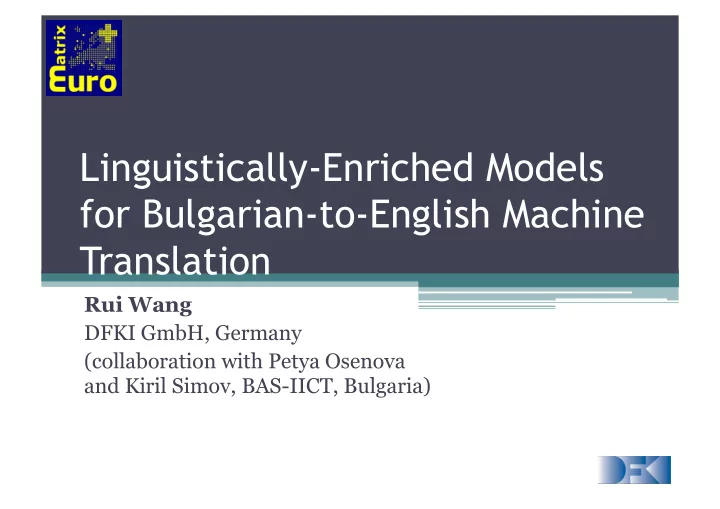

Linguistically-Enriched Models for Bulgarian-to-English Machine Translation Rui Wang DFKI GmbH, Germany (collaboration with Petya Osenova and Kiril Simov, BAS-IICT, Bulgaria)
2 SSST-6, Jeju, Korea 7/12/12 In a Nutshell • Bulgarian English • Factored SMT models to incorporate linguistic knowledge • Question-based manual evaluation
3 SSST-6, Jeju, Korea 7/12/12 Motivation • Incorporating linguistic knowledge into statistical models, same for MT • Different strategies ▫ Post-editing ▫ System combination
4 SSST-6, Jeju, Korea 7/12/12 Our Strategy • Good baseline result (38.61 BLEU by Moses) • Various linguistic knowledge from preprocessing ▫ Morphological analysis, lemmatization, POS tagging ▫ (CoNLL) Syntactic dependency tree ▫ (R)MRS • ‘Supertagging’-style
5 SSST-6, Jeju, 7/12/12 Korea Related Work • Birch et al. (2007) and Hassan et al. (2007) ▫ Supertags on English side • Singh and Bandyopadhyay (2010) ▫ Manipuri-English bidirectional translation • Bond et al. (2005), Oepen et al. (2007), Graham and van Genabith (2008), and Graham et al. (2009) ▫ Transfer-based MT
6 SSST-6, Jeju, Korea 7/12/12 Factored Model • Koehn and Hoang (2007) ▫ Easily incorporate linguistic features at the token level ▫ Similar to ‘supertags’ • WF, Lemma, POS, Ling • DepRel, HLemma, HPOS • EP, EoV, ARGnEP, ARGnPOS
7 SSST-6, Jeju, Korea 7/12/12 Preprocessing • POS Tagging – 97.98% accuracy Lemmatization – 95.23 % accuracy ▫ Georgiev et al., 2012 • Dependency Parsing – 87.6 % labeled parsing accuracy ▫ Savkov et al., 2012
8 SSST-6, Jeju, Korea 7/12/12 Example • Spored odita v elektricheskite kompanii politicite zloupotrebyavat s dyrzhavnite predpriyatiya. • Electricity audits prove politicians abusing public companies.
9 SSST-6, Jeju, Korea 7/12/12 Factors
10 SSST-6, Jeju, Korea 7/12/12 Minimal Recursion Semantics (MRS) • MRS Structure: <GT, R, C> ▫ GT: Top ▫ R: a bag of EPs ▫ C: Handle Constraints , the outscopes order between the EPs • Examples: ▫ <h0, {h1:every(x, h2, h3), h2:dog(x), h4:chase(x, y), h5:some(y, h6, h7), h6:white(y), h6:cat(y)}, {}>
11 SSST-6, Jeju, Korea 7/12/12 (Fallback) Rules for RMRS • <Lemma, MSTag> EP-RMRS ▫ The rules of this type produce an RMRS including an elementary predicate • <DRMRS, Rel, HRMRS> HRMRS' ▫ The rules of this type unite the RMRS constructed for a dependent node (DRMRS) into the current RMRS for a head node (HRMRS)
12 SSST-6, Jeju, Korea 7/12/12 Factors (cont.)
13 SSST-6, Jeju, Korea 7/12/12 Example
14 SSST-6, Jeju, Korea 7/12/12 Experiments • GIZA++ (Och and Ney, 2003) • A tri-gram language model is estimated using the SRILM toolkit (Stolcke, 2002) • Minimum error rate training (MERT) (Och, 2003) is applied to tune the weights for the set of feature weights that maximizes the BLEU score on the development se
15 SSST-6, Jeju, Korea 7/12/12 Corpora • Train/Dev/Test • SETIMES ▫ 150,000(100,000)/500/1,000 • EMEA ▫ 700,000/500/1,000 • JRC-Acquis ▫ 0/0/4,107
16 SSST-6, Jeju, Korea 7/12/12 Results
17 SSST-6, Jeju, Korea 7/12/12 Results (cont.)
18 SSST-6, Jeju, Korea 7/12/12 Manual Evaluation • Motivation ▫ BLEU score in high range is not differentiable ▫ Impacts from various linguistic knowledge • Evaluation metrics ▫ Grammaticality ▫ Content
19 SSST-6, Jeju, Korea 7/12/12 Results
20 SSST-6, Jeju, Korea 7/12/12 Question-Based Evaluation • Either like it or dislike it • A set of questions based on dependency relations • Answers to judge • Similar to PETE (Yuret te al., 2010)
21 SSST-6, Jeju, Korea 7/12/12 Conclusion • Factored model is nice tool to incorporate morphological features ▫ Sparsity • Syntactic/Semantic information without structure is not so helpful ▫ Deeper transfer
22 SSST-6, Jeju, Korea 7/12/12 More Issues • Morphology ▫ Somehow handled by the factored model • Semantic empty words ▫ Difficult for word alignment • Reordering ▫ Difficult without structural information
23 SSST-6, Jeju, 7/12/12 Korea Acknowledgements • EuroMatrixPlus (IST-231720) • Tania Avgustinova for fruitful discussions and her helpful linguistic analysis • Laska Laskova, Stanislava Kancheva and Ivaylo Radev for doing the human evaluation of the data
Thank YOU! Questions?
25 SSST-6, Jeju, Korea 7/12/12 MRS (cont.) • Elementary Predication (EP) ▫ h2:every(y, h3, h4) handle relation list of ordinary variables (zero or more) list of handles (zero or more)
26 SSST-6, Jeju, Korea 7/12/12 Scope Underspecification • Examples • Every dog chases some white cat. (a) some(y, white(y) ∧ cat(y), every(x, dog(x), chase(x, y))) (b) every(x, dog(x), some(y, white(y) ∧ cat(y), chase(x, y))) h1:every(x, h3, h4), h3:dog(x), h1:every(x, h3, h5), h3:dog(x), h7:white(y), h7:cat(y), h7:white(y), h7:cat(y), h5:some(y, h7, h1), h4:chase(x,y) h5:some(y, h7, h4), h4:chase(x, y)
27 SSST-6, Jeju, Korea 7/12/12 Manual Evaluation – Grammaticality 1. The translation is not understandable. 2. The evaluator can somehow guess the meaning, but cannot fully understand the whole text. 3. The translation is understandable, but with some efforts. 4. The translation is quite fluent with some mi- nor mistakes or re-ordering of the words. 5. The translation is perfectly readable and grammatical.
28 SSST-6, Jeju, Korea 7/12/12 Manual Evaluation – Content 1. The translation is totally different from the reference. 2. About 20% of the content is translated, missing the major content/topic. 3. About 50% of the content is translated, with some missing parts. 4. About 80% of the content is translated, missing only minor things. 5. All the content is translated.
Recommend
More recommend